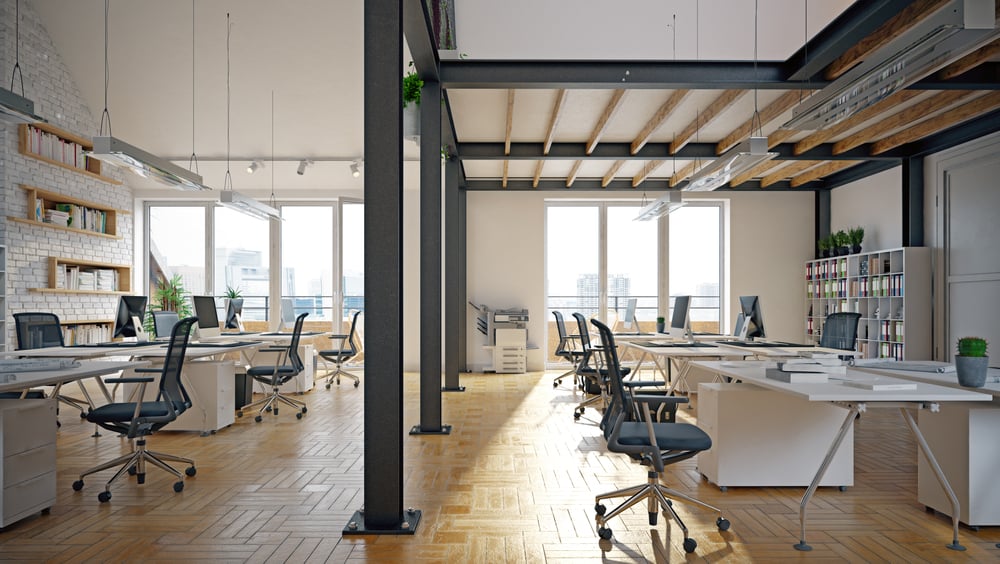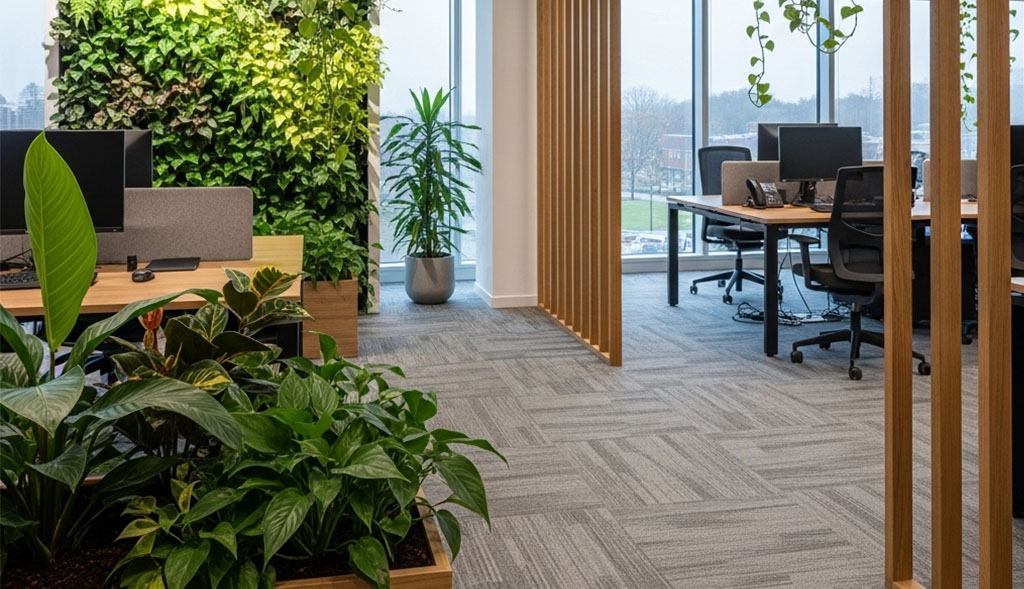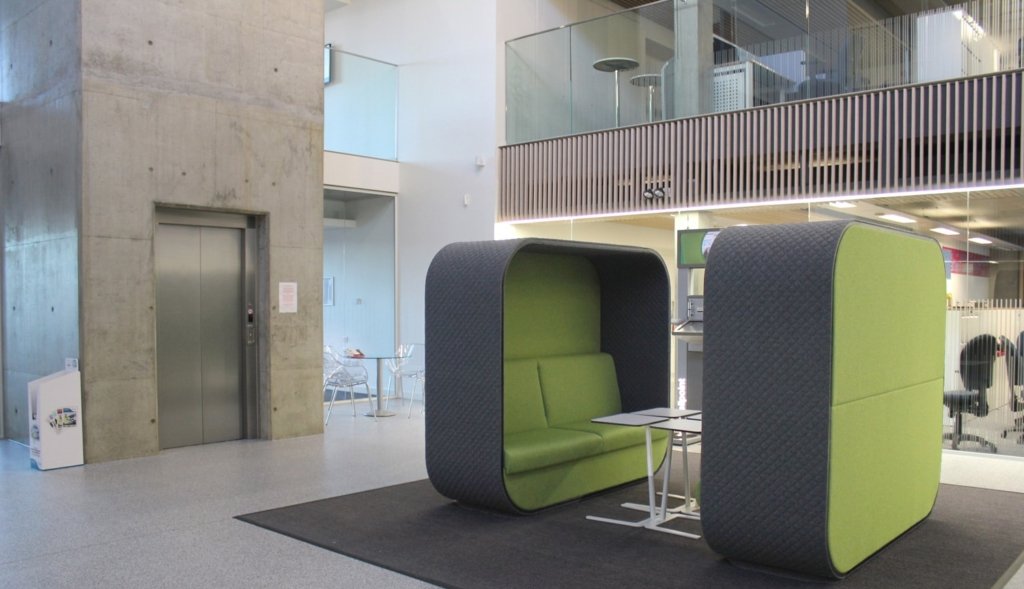Top Modern Office Design Trends for 2025

Offices in 2025 will no longer resemble classic, traditional spaces with desks stacked together and closed rooms.
The business environment in Houston is changing at an unprecedented pace, and remote working and hybrid work models, technological advances, and a new look at mental health and job satisfaction are no longer allowing the office to remain the same repetitive structure of the past.
New office design trends are emerging to meet the changing needs of today’s workforce.
Let’s see what the top modern office design trends are for 2025.
In 2025, office design trends focus on flexible, hybrid workspaces with modular furniture that adapts to various needs.
Ergonomic furniture will dominate, promoting employee health and comfort.
Offices will incorporate biophilic design, adding plants and natural elements for a calming environment.
Sustainable materials and smart technology will further enhance functionality, supporting productivity and reducing environmental impact.
From open floor plans to eco-friendly materials, offices are designed to promote collaboration, flexibility, and well-being.
The use of technology and innovation is also changing the way we work and creating new opportunities for workplace design.
As the lines between work and home blur and remote work becomes more common, the office is evolving to accommodate the modern workforce.
In this article, we will explore the Top Modern Office Design Trends for 2025 so you can create the best workspace for your employees.
1. Flexible and Modular Workspaces

The concept of traditional workspaces is changing in response to fundamental shifts in work models, particularly with the spread of remote working and hybrid work models.
Fixed desks and private office cubicles for employees are no longer seen as separate and individual.
Businesses are moving toward designing spaces that are both flexible and can quickly adapt to the changing needs of teams.
- Hot Desking and Free Desking: These are two similar models of working with any specific desk, where employees have no fixed desk.
Employees can use any available office shared desk whenever they enter the office.
Designing a workspace with these desks is more suitable for hybrid workspaces where people sometimes work at home and sometimes in the office.
This type of design allows for optimal use of space and maximum efficiency.
Also, costs can be greatly reduced by eliminating the need for a large number of desks and physical space.
Using this office desk model, interaction between teams can be strengthened by breaking the traditional structure.
- Modular Office Furniture: In today’s changing world, space must adapt to business performance.
Using modular office furniture Houston in office space design is a suitable answer to this need.
This type of furniture and equipment can be moved, adjusted, and recombined to easily accommodate a variety of work activities, from team meetings to individual work.
Modular furniture includes height-adjustable desks, demountable and movable walls, office chairs, and tables that can be quickly rearranged, and lightweight partitions.
This type of furniture is one of the most popular in modern office design trends for 2025, which enhances business performance by increasing flexibility in operation without the need for construction.
It is also possible to quickly redesign the environment based on business needs.
2. Biophilic Design and Natural Elements
In most businesses today, technology has taken over a large part of our working lives, so the need to reconnect with nature is felt more than ever.
Biophilic Design is a unique choice to meet this need.
This approach purposefully and directly introduces nature into indoor spaces, especially work environments, to enhance people’s physical and mental health and productivity.
- Incorporation of Nature: One of the main aspects of biophilic design is the introduction of natural elements into artificial environments such as offices.
This integration can be done in many ways. You can use live plants, pots, green walls, and shrubs.
In this design, natural light should enter the rooms and space through large windows and glass ceilings.
You can also use natural materials such as wood, stone, bamboo, fiber fabrics, and natural textures in furniture and flooring.
- Health Benefits: The presence of natural elements in workplaces has a direct impact on the mental and physical health of employees.
Seeing plants or being exposed to natural light can reduce the stress hormone in the body.
Even looking at a picture of a natural landscape can slow down your heart rate.
The presence of natural elements also enhances feelings of happiness, peace, and job satisfaction.
In environments with biophilic design, mental fatigue is reduced.
In addition to their aesthetic appeal, plants also help improve breathing quality by filtering the air and producing oxygen.

3. Sustainability and Eco-Conscious Materials
Today, with awareness of environmental issues, environmental responsibility has become one of the essential priorities of organizations.
Therefore, another top modern office design trend for 2025 is the use of sustainable materials in design.
- Green Materials: A large part of sustainable design is related to the type of materials used in the construction and layout of the space.
In modern office interior design, the use of environmentally friendly materials has become increasingly popular.
In this type of design, recycled or FSC-certified wood and sustainable sources can be used instead of cutting down trees.
Also, using low-VOC paints can keep indoor air quality high.
Using natural fibers such as hemp, bamboo, organic cotton, or recycled fabrics in furniture, curtains, and flooring can help reduce environmental impact.
- Energy Efficiency: Another aspect of sustainability relates to how energy is consumed in space.
Smart design of workplaces, using efficient equipment, helps reduce the carbon footprint.
For this purpose, LED lights can be used instead of old bulbs, and motion or light sensors can be used to automatically turn lights on and off.
Smart air conditioning systems adjust the room temperature based on occupancy, outside temperature, or time of day, reducing energy consumption.
By using sunlight in space design, the need for artificial lighting is reduced.
4. Smart Technology Integration
Today’s workplace has become a smart, dynamic, and responsive environment.
Integrating modern technologies into office design in 2025 improves the work experience for both in-person and remote employees, while optimizing efficiency and resource utilization.
- IoT Devices: Internet of Things technology allows devices to communicate with each other and with employees.
This capability in the office space means creating a smart environment that adjusts itself based on the needs of individuals and environmental conditions.
Smart Lighting, Smart Climate Control, and Occupancy Sensors all create an ideal environment for employees and managers that reduces energy consumption and increases productivity.
- Advanced Conferencing Tools: In modern offices, meetings are rarely entirely in-person, and usually, part of the team connects remotely.
So, meeting technologies need to create a comfortable experience for everyone.
These smart tools include AI-powered Cameras that automatically zoom in and adjust positions on the person speaking, and microphones that eliminate ambient noise and pick up sound from multiple directions.
5. Wellness-Centered Designs
In recent years, maintaining employee health in workplaces has become a necessity.
Wellness-Centric Design means that all physical and psychological aspects of employees are considered in the design of the environment to both increase efficiency and increase job satisfaction.
- Ergonomic Furniture and Physical Wellness: One type of ergonomic office furniture is standing desks, which allow employees to switch between sitting and standing throughout the day.
This change in position reduces back pain, improves circulation, and increases energy.
Also, ergonomic chairs are designed to support the lower back, neck, and spine.
These office chairs are adjustable and help users maintain a proper sitting posture.
Wellness rooms are also spaces for stretching, meditation, short breaks, or even light exercise.
- Mental Health Support through Design: Noisy, stressful, and crowded work environments have profound negative effects on workers’ mental health.
New designs in 2025 will try to help improve concentration, reduce anxiety, and increase employee satisfaction by creating spaces specifically for mental peace.
Spaces such as quiet zones and relaxation spaces, along with soothing colors and direct sunlight, can help reduce stress and maintain mental health.
6. Focus on Acoustic Solutions

Open offices are one of the workplace design trends in 2025, and one of the major challenges of these spaces is noise pollution and distraction caused by annoying sounds.
To respond to this challenge, acoustic solutions play an important role in office interior design to create a more balanced space suitable for focused work.
- Soundproofing: One of the main methods of reducing noise in offices is to use acoustic materials to absorb or block sound.
Acoustic panels, soft flooring, false ceilings equipped with sound-absorbing materials, as well as acoustic partitions play a major role in creating such acoustic spaces.
- Private Soundproof Pods: For times when employees need full focus, private calls, or confidential meetings, having fully isolated spaces is crucial.
Focus pods are small, isolated rooms where a person can focus on individual work without external distractions.
These private pods usually have adequate lighting, ventilation, and even internal soundproofing.
Call or video conference booths are also a very efficient option for answering calls or online meetings in busy environments.
7. Home-Inspired Interiors or Resimercial Design
In the new era of business, especially with the emergence of the hybrid work model, the line between home and office has become increasingly blurred.
This change has inspired a new approach to workspace design.
The combination of residential design with commercial design is called Resimercial.
- Home-Like Comfort: In previous years, the traditional work environment was often cold and formal.
In contrast, Resimercial design, one of the top modern office design trends for 2025, strives to provide an environment where employees feel comfortable, safe, and belong.
Comfortable office furniture, soft lighting, home decorative elements, and spaces such as home kitchens are among the things used in creating these types of spaces.
8. Inclusive and Neurodiverse Spaces
In 2025, office designers will strive to create environments that are usable and relaxing for all people and needs.
One of the most important aspects to consider is neurodiversity.
It means recognizing that human brains think, sense, and process information in different ways.
People on the autism spectrum, those living with ADHD, anxiety, sensory processing disorder, or other neurological conditions, can be highly focused, creative, and productive when provided with the right environment.
- Design for All: Inclusive design means creating a space that takes into account the needs of all employees with individual differences.
This type of design offers a variety of spaces, from open social spaces to private rooms, so that each user can choose a location that suits their work style.
The ability to adjust sound, light, temperature, and even workspace allows the user to tailor the environmental conditions based on their neurological and sensory preferences.
This design also uses distinct colors, simple signs, and clear signage to help people with cognitive impairments or spatial anxiety navigate the environment more easily.
- Sensory Considerations: For many people, bright light, loud noises, strong smells, or crowded environments are very bothersome.
Inclusive design recognizes these differences and provides an adaptable and flexible environment.
Soft lighting, quiet zones, and using sound-absorbing partitions are all effective in creating a suitable space for these people.

9. Community and Collaboration Zones
In modern workplaces, the success of organizations depends on the power of interaction, trust, and group creativity.
Therefore, designing spaces that enhance team communication, exchange of ideas, and information has become one of the top priorities in today’s offices.
Community and collaborative spaces are designed to both facilitate informal interaction and provide a suitable infrastructure for meetings, brainstorming, and group activities.
- Social Hubs: The goal of creating Social Hubs is to provide people with the opportunity to talk, relax, and establish human connections in intimate and free environments, in addition to official work.
Coffee bars, lounges, comfortable living spaces, and common dining areas all help in forming strong relationships between employees and creating interaction.
- Collaborative Spaces: Effective collaboration requires flexibly designed spaces where teams can come and work together without physical or technical constraints.
These include flexible meeting rooms, open-plan spaces for group work, and rooms for team or project work.
10. Bold and Vibrant Color Schemes
Colors play an important role in workplace psychology, so modern designs in 2025 are trying to focus on colors and their combinations.
They can evoke emotions, influence behavior, and even alter mental functioning.
For this reason, the conscious use of vibrant and bold colors in office design is an essential tool for creating an energetic, inspiring environment that is in harmony with the organizational culture.
- Color Psychology: Bold colors, such as red, orange, bright blue, lime green, or bright yellow, interact with the human nervous system and can create specific mental and emotional reactions.
Using these colors in walls, furniture, decor, and lighting helps teams become more engaged in the space and more productive.
- Brand Identity: Integrating brand colors into interior design is an effective way to strengthen organizational culture, increase a sense of belonging, and align the environment with company values.
In such an environment, the sense of belonging and pride in being part of a team increases among employees.
Conclusion
As discussed in the article Top Modern Office Design Trends for 2025, the workspace has become dynamic, flexible, and human-centered.
Trends such as hybrid design, smart technologies, natural elements, and inclusive spaces all show that employee-centricity and innovation are at the heart of future office design.
Businesses that embrace these changes with a forward-looking perspective and redesign their work environments with these trends will not only experience greater productivity and job satisfaction but will also be more successful in attracting and retaining talent.
If you’re looking for ways to create a modern, functional, and inviting office space that meets the needs of today’s workplace, Collaborative Office Interiors offers guidance to create and maximize a modern, functional, and inviting office space tailored to the needs of today’s workforce.
We provide layout strategies and types of furniture with both aesthetic and practical considerations, as well as other resources needed to transform any workspace into an efficient hub of productivity.
Now is the best time for companies to rethink their current office design and move towards creating environments that are both adaptable to work needs and flexible and efficient.

John Ofield is the owner of Collaborative Office Interiors. Houston’s trusted source for modern and commercial office furniture, office cubicles, demountable walls, office desks and tables, and complete workspace solutions. With more than 40 years of experience, he combines deep product knowledge with hands-on space-planning expertise to create ergonomic, productivity-focused work environments for businesses across Southeast Texas.


